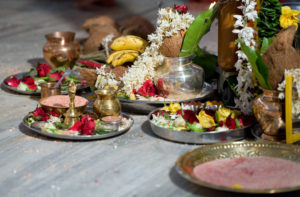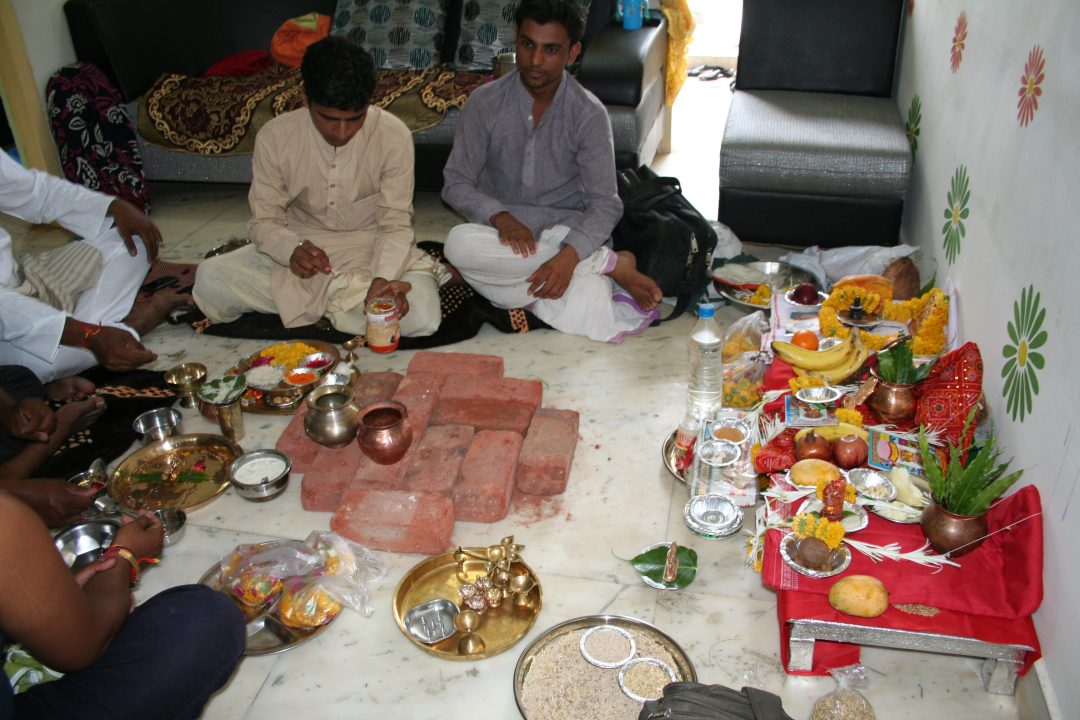“Puja” is a commonly used word for worship. A Puja can be as simple as lighting a lamp and saying a Mantra,or an elaborate ritualistic event conducted in a Temple. almost all Hindus with the exception of strict atheists indulge in a form of Puja, one way or the other. It is well known that God is worshiped in many forms, with many names in Hinduism. But, Puja to all forms of God have some common underlying features.
In its simplest form, a Puja involves the following rituals:
A devotee, about to perform a Puja, is generally freshly bathed.
He stands in front of his God. This can be an Idol or a picture of his favorite God. with hands folded in the form of NAMASTE, he bows his head and utters a prayer. This posture indicates his surrender to God and acceptance of the supreme being. Though there are several different rituals throughout India, one of the most universal features is that all Pujas commence with the invocation of the Elephant headed God, Lord Ganesh. He is purported to be the remover of obstacles, thus ensuring smooths sailing in the devotee’s mind. While this may be construed as a blind belief, the ancient philosophers had another reason for this. Namely, calming the mind of the devotee, as he focuses on prayer. Next, he indulges in the recitation of Mantras. Here is where the simplicity of complex steps in. He may recite a simple single mantra, or he may recite several of them.
 He continues to pray and pay respect to the other Gods. Generally included are the Hindu Trinity. Next, come the Navagrahas ( Nine planets )Every Hindu household has a ruling deity, pre-designated by their ancestors. This Deity is known as the Deity of the house and is invoked next. Last, but not the least, the devotee prays to his Ishta Devatha, i.e. the God that he personally likes. He has the freedom to choose any one of the multitudes of Deities available in the Hindu religion. Since ultimately, they are all considered to be one, no one argues this point.
He continues to pray and pay respect to the other Gods. Generally included are the Hindu Trinity. Next, come the Navagrahas ( Nine planets )Every Hindu household has a ruling deity, pre-designated by their ancestors. This Deity is known as the Deity of the house and is invoked next. Last, but not the least, the devotee prays to his Ishta Devatha, i.e. the God that he personally likes. He has the freedom to choose any one of the multitudes of Deities available in the Hindu religion. Since ultimately, they are all considered to be one, no one argues this point.
After having completed the invocation, he carries on with the ritual. It consists of offering flowers and lighting a lamp. Lighting an oil lamp is one of the most significant features of a Hindu Puja. While many reasons are cited for this, one of the foremost is the fact that all flames rise upward, comparing it to the upward rise of thought and soul, rising to meet the Supreme Being. In most South Indian rituals, the offering of Red and Yellow-colored powders, Kunkum and Turmeric are an integral part of the Puja. This is also accompanied by the offering of Red and Yellow-colored rice. In some Pujsa, Vibhuthi, i.e. the ash of the incense stick is offered to the devotees.
An offering of some kind of food is made to God.
It could be a plain fruit, a simple mixture of raisins and nuts, or delicately prepared food of any kind. This food is never sampled for taste during preparation and is called PRASAD. Noteworthy is the fact that a strict Hindu does not eat before a Puja. After offering it to God, it is distributed to the devotees. Refusing this PRASAD is considered a sacrilege.
Going around the Deity at least three times completes the ritual.
In the absence of this, the devotee can turn around three times. This act signifies that he is encircling God within himself. Lying prostrate in front of God, called NAMASKAR, completes the Puja.
The simplest form of Puja, without the involvement of a priest
It can be performed both by men and women. This basic concept can be carried to the highest degree. It can be done at home or in a hall or at the Temple, where the officiating priest is almost always a male. Chanting the name of God, music and the accompaniment of ringing bells and drumbeat adds to the atmosphere.






